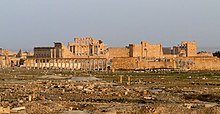History:
Main article: History of
Syria
 Since approximately 10,000 BC, Syria was one of centers of Neolithic culture (known as Pre-Pottery Neolithic A) where agriculture and
cattle breeding appeared for the first time in the world. The following
Neolithic period (PPNB) is
represented by rectangular houses of Mureybet culture. At the time of the pre-pottery
Neolithic, people used vessels made of stone, gyps and burnt lime (Vaiselles
blanches). Finds of obsidian
tools from Anatolia are evidences of
early trade relations. Cities of Hamoukar and Emar
played an important role during the late Neolithic and Bronze Age. Archaeologists have demonstrated that
civilization in Syria was one of the most ancient on earth.
Since approximately 10,000 BC, Syria was one of centers of Neolithic culture (known as Pre-Pottery Neolithic A) where agriculture and
cattle breeding appeared for the first time in the world. The following
Neolithic period (PPNB) is
represented by rectangular houses of Mureybet culture. At the time of the pre-pottery
Neolithic, people used vessels made of stone, gyps and burnt lime (Vaiselles
blanches). Finds of obsidian
tools from Anatolia are evidences of
early trade relations. Cities of Hamoukar and Emar
played an important role during the late Neolithic and Bronze Age. Archaeologists have demonstrated that
civilization in Syria was one of the most ancient on earth.Eventually, the Persians took Syria as part of their hegemony of Southwest Asia; this dominion was transferred to the Ancient Macedonians and Greeks after Alexander the Great's conquests and the Seleucid Empire. Pompey the Great captured Antioch in 64 BC, turning Syria into a Roman province. Thus control of this region passed to the Romans and then the Byzantines.
The population of Syria during the heyday of the empire was probably not exceeded again until the 19th century. Syria's large and prosperous population made Syria one of the most important of the Roman provinces, particularly during the 2nd and 3rd centuries (AD).
The Roman Emperor Alexander Severus, who was emperor from 222 to 235, was Syrian. His cousin Elagabalus, who was emperor from 218 to 222, was also Syrian and his family held hereditary rights to the high priesthood of the sun god El-Gabal at Emesa (modern Homs) in Syria. Another Roman emperor who was a Syrian was Philip the Arab (Marcus Julius Philippus), emperor from 244 to 249.
Syria is significant in the history of Christianity; Saulus of Tarsus, better known as the Apostle Paul, was converted on the Road to Damascus and emerged as a significant figure in the Christian Church at Antioch in ancient Syria, from which he left on many of his missionary journeys.

